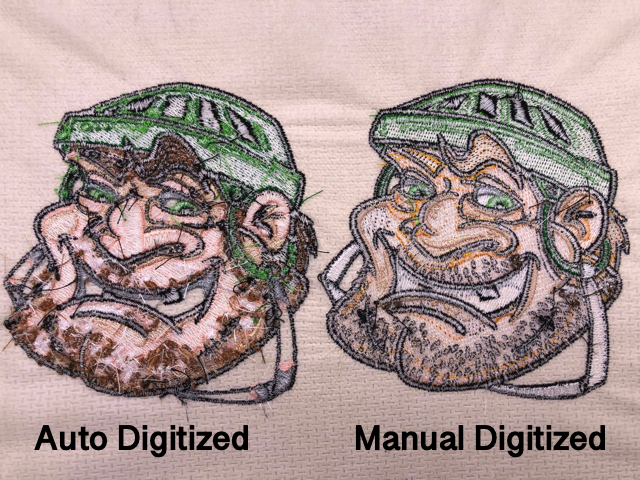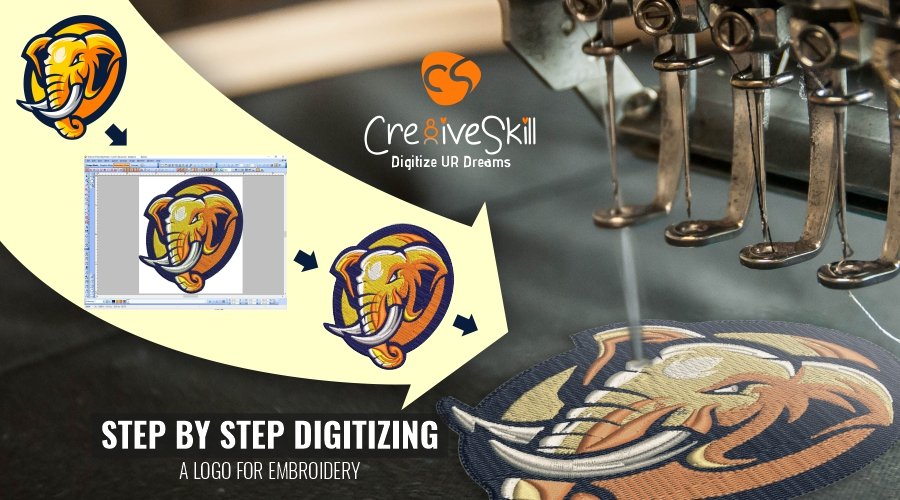Budget Friendly Digitizing for Embroidery: Accuracy and Detail
Budget Friendly Digitizing for Embroidery: Accuracy and Detail
Blog Article
Mastering the Embroidery Digitizing Refine: Your Ultimate Overview
Embroidery digitizing is a thorough craft that calls for accuracy and know-how to translate intricate layouts right into electronic layouts for equipment needlework. As craftsmens start this trip to master the needlework digitizing process, a detailed understanding of the basics sets the foundation for quality. Nevertheless, past the primary knowledge exists a world of sophisticated software application, specialized devices, and nuanced techniques waiting to be discovered. By diving right into the subtleties of digitizing, one can unlock a world of creative opportunities and boost their needlework projects to brand-new elevations.

Recognizing Needlework Digitizing Basics
Embroidery digitizing fundamentals create the foundation whereupon complex layouts are converted into machine-readable formats for exact sewing. This initial action in the needlework digitizing procedure is crucial for guaranteeing that the last embroidered product is a faithful depiction of the initial style. Comprehending needlework digitizing basics involves realizing key concepts such as stitch kinds, sew instructions, density, underlay, and draw payment.
Stitch types play a crucial duty in establishing the visual and textural end result of the stitched design. By choosing the proper stitch kind, whether it be satin, fill, or running stitch, digitizers can attain the desired impact and improve the total high quality of the embroidery. Additionally, sew instructions affects the circulation and dimension of the design, while thickness figures out the spacing and protection of the stitches.
In addition, underlay stitching offers security to the layout by protecting the fabric and avoiding distortion during the embroidery process. Pull settlement is an additional essential factor to consider to neutralize the natural propensity of textile to contract when sewn. Mastering these embroidery digitizing basics is basic for developing professional-quality embroidered products.
Choosing the Right Digitizing Software
Choosing the suitable digitizing software program is a critical choice that considerably influences the performance and top quality of the embroidery digitizing process. Digitizing for Embroidery. When choosing the best digitizing software, it is vital to think about factors such as the complexity of designs you prepare to create, the user-friendliness of the software program, the level of client support used, and the compatibility with your embroidery device
There are various digitizing software application options available in the marketplace, ranging from basic programs for newbies to sophisticated software program for professional digitizers. Some popular options include Wilcom EmbroideryStudio, Hatch Needlework Software Program, and PulseID. These software offer a vast array of tools and functions to assist you develop intricate layouts effortlessly.
Prior to making a choice, it is suggested to explore the various software program choices through complimentary trials or trials to identify which one ideal suits your demands. In addition, reviewing evaluations and seeking recommendations from skilled digitizers can provide beneficial understandings into the toughness and weaknesses of each software package (Digitizing for Embroidery). By carefully evaluating your demands and comparing the attributes of various digitizing software, you can make an informed option that enhances your needlework digitizing operations
Digitizing Devices and Techniques

Optimizing Design Settings for Embroidery
Mastering the complexities of design setups is basic in accomplishing optimum outcomes in the embroidery digitizing procedure, structure upon the foundation laid by understanding digitizing tools and strategies. When maximizing style setups for embroidery, it is essential to take into consideration elements such as stitch type, density, rug, pull payment, and enrollment. Enrollment settings line up various elements of the style properly, maintaining general design stability.

Troubleshooting Common Digitizing Issues
When running into typical digitizing concerns throughout the embroidery procedure, it is necessary to recognize the root creates and execute reliable options promptly. One typical issue is stitch thickness problems, where stitches may be as well dense, triggering the fabric to pucker, or too sporadic, leading to gaps in the style. Readjusting the stitch thickness setups in the digitizing software application can aid resolve this problem.
An additional constant difficulty is string breaks throughout the embroidery process. This can happen because of numerous reasons such as wrong stress setups, dull needles, or using low-grade thread. Ensuring proper upkeep of the needlework maker, consisting of routine needle modifications and tension modifications, can minimize the incident of string breaks.
Furthermore, design enrollment mistakes can result in misaligned elements within the embroidery style. Checking the layout placement in the digitizing software application and making essential changes before sewing can help in avoiding this concern. By attending to these common digitizing problems without delay and efficiently, you can make certain a smoother needlework process and high-grade finished products.
Conclusion
To conclude, understanding the needlework digitizing process requires a strong understanding of the you could check here basics, the right selection of software program, and understanding of devices and methods. Optimizing design setups and repairing common digitizing issues are critical action in making certain high-quality embroidery results. By following these steps diligently, one can achieve accuracy and performance in the digitizing procedure.
Report this page